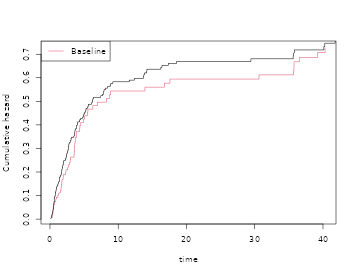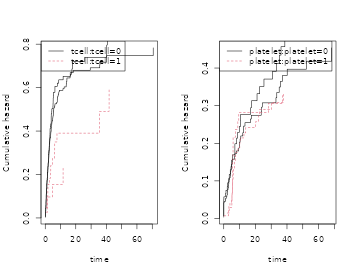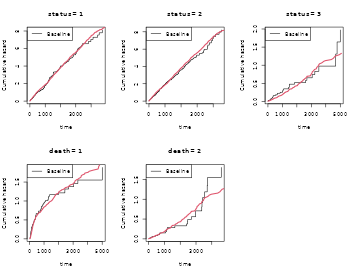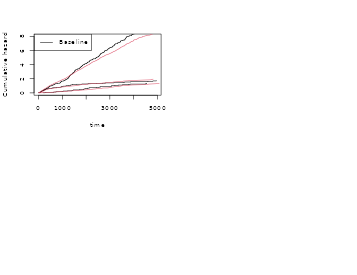
WIP: Cooking survival data, 5 minute recipes
2025-11-17
Source:vignettes/cooking-survival-data.Rmd
cooking-survival-data.RmdOverview
Simulation of survival data is important for both theoretical and practical work. In a practical setting we might wish to validate that standard errors are valid even in a rather small sample, or validate that a complicated procedure is doing as intended. Therefore it is useful to have simple tools for generating survival data that looks as much as possible like particular data. In a theoretical setting we often are interested in evaluating the finite sample properties of a new procedure in different settings that often are motivated by a specific practical problem. The aim is provide such tools.
Bender et al. in a nice paper discussed how to generate survival data based on the Cox model, and restricted attention to some of the many useful parametric survival models (weibull, exponential). We here use piecwise linear baseline functions that make it easy to simulate data that follows closely the baseline given by the data using semi or nonparametric models. THis makes it easy to capture important aspects of the data.
Different survival models can be cooked, and we here give recipes for hazard and cumulative incidence based simulations. More recipes are given in vignette about recurrent events.
- hazard based.
- cumulative incidence.
- recurrent events (see recurrent events vignette).
Hazard based, Cox models
Given a survival time with cumulative hazard , it follows that with (exponential with rate 1), that will have the same distribution as .
This provides the basis for simulations of survival times with a given hazard and is a consequence of this simple calculation
Similarly if given have hazard on Cox form where is a -dimensional regression coefficient and a baseline hazard funcion, then it is useful to observe also that with has the same distribution as given .
Therefore if the inverse of the cumulative hazard can be computed we can generate survival with a specified hazard function. One useful observation is note that for a piecewise linear continuous cumulative hazard on an interval it is easy to compute the inverse.
Further, we can approximate any cumulative hazard with a piecewise linear continous cumulative hazard and then simulate data according to this approximation. Recall that fitting the Cox model to data will give a piecewise constant cumulative hazard and the regression coefficients so with these at hand we can first approximate the piecewise constant “Breslow”-estimator with a linear upper (or lower bound) by simply connecting the values by straight lines.
Delayed entry
If
given
have hazard on Cox form
and we wish to generate data according
to this hazard for those that are alive at time
,
that is draw from the distribution of
given
(all given
), then we note that
with
and with
has the distributiion we are after.
This is again a consequence of a simple calculation
The engine is to simulate data with a given linear cumulative hazard. First generating survival data based on the cumulative hazard cumhaz:j
nsim <- 200
chaz <- c(0,1,1.5,2,2.1)
breaks <- c(0,10, 20, 30, 40)
cumhaz <- cbind(breaks,chaz)
X <- rbinom(nsim,1,0.5)
beta <- 0.2
rrcox <- exp(X * beta)
pctime <- rchaz(cumhaz,n=nsim)
pctimecox <- rchaz(cumhaz,rrcox)Now looking at a simple cox model
library(mets)
n <- 100
data(bmt)
bmt$bmi <- rnorm(408)
dcut(bmt) <- gage~age
data <- bmt
cox1 <- phreg(Surv(time,cause==1)~tcell+platelet+age,data=bmt)
dd <- sim.phreg(cox1,n,data=bmt)
dtable(dd,~status)
#>
#> status
#> 0 1
#> 54 46
scox1 <- phreg(Surv(time,status==1)~tcell+platelet+age,data=dd)
cbind(coef(cox1),coef(scox1))
#> [,1] [,2]
#> tcell -0.6517920 -0.8108950
#> platelet -0.5207454 -0.5471871
#> age 0.4083098 0.4390413
par(mfrow=c(1,1))
plot(scox1,col=2); plot(cox1,add=TRUE,col=1)
## changing the parametes
cox10 <- cox1
cox10$coef <- c(0,0.4,0.3)
dd <- sim.phreg(cox10,n,data=bmt)
dtable(dd,~status)
#>
#> status
#> 0 1
#> 41 59
scox1 <- phreg(Surv(time,status==1)~tcell+platelet+age,data=dd)
cbind(coef(cox10),coef(scox1))
#> [,1] [,2]
#> tcell 0.0 0.1752103
#> platelet 0.4 0.4409485
#> age 0.3 0.1086505
par(mfrow=c(1,1))
plot(scox1,col=2); plot(cox10,add=TRUE,col=1)
Multiple Cox models for cause specific hazards can be combined, and we start by drawing the covariates manually, below we just call the sim.phregs function that draws covariates from the data,
data(bmt);
cox1 <- phreg(Surv(time,cause==1)~tcell+platelet,data=bmt)
cox2 <- phreg(Surv(time,cause==2)~tcell+platelet,data=bmt)
X1 <- bmt[,c("tcell","platelet")]
n <- nsim
xid <- sample(1:nrow(X1),n,replace=TRUE)
Z1 <- X1[xid,]
Z2 <- X1[xid,]
rr1 <- exp(as.matrix(Z1) %*% cox1$coef)
rr2 <- exp(as.matrix(Z2) %*% cox2$coef)
d <- rcrisk(cox1$cum,cox2$cum,rr1,rr2)
dd <- cbind(d,Z1)
scox1 <- phreg(Surv(time,status==1)~tcell+platelet,data=dd)
scox2 <- phreg(Surv(time,status==2)~tcell+platelet,data=dd)
par(mfrow=c(1,2))
plot(cox1); plot(scox1,add=TRUE,col=2)
plot(cox2); plot(scox2,add=TRUE,col=2)
cbind(cox1$coef,scox1$coef,cox2$coef,scox2$coef)
#> [,1] [,2] [,3] [,4]
#> tcell -0.4232606 -0.6808494 0.3991068 0.2044248
#> platelet -0.5654438 -0.3404486 -0.2461474 -0.1388716Now fully nonparametric model with stratified baselines and specific call of sim.base function
data(sTRACE)
dtable(sTRACE,~chf+diabetes)
#>
#> diabetes 0 1
#> chf
#> 0 223 16
#> 1 230 31
coxs <- phreg(Surv(time,status==9)~strata(diabetes,chf),data=sTRACE)
strata <- sample(0:3,nsim,replace=TRUE)
simb <- sim.base(coxs$cumhaz,nsim,stratajump=coxs$strata.jumps,strata=strata)
cc <- phreg(Surv(time,status)~strata(strata),data=simb)
plot(coxs,col=1); plot(cc,add=TRUE,col=2)
We now fit 3 cause-specific hazard models and generate competing risks data with hazards taken from the fitted Cox models. Here a complex situation with stratified baselines of some of the models.
## stratified with phreg
cox0 <- phreg(Surv(time,cause==0)~tcell+platelet,data=bmt)
cox1 <- phreg(Surv(time,cause==1)~tcell+platelet,data=bmt)
cox2 <- phreg(Surv(time,cause==2)~strata(tcell)+platelet,data=bmt)
coxs <- list(cox0,cox1,cox2)
### dd <- sim.cause.cox(coxs,nsim,data=bmt)
dd <- sim.phregs(coxs,n,data=bmt)
## checking that cause specific hazards are as given, make n larger
scox0 <- phreg(Surv(time,status==1)~tcell+platelet,data=dd)
scox1 <- phreg(Surv(time,status==2)~tcell+platelet,data=dd)
scox2 <- phreg(Surv(time,status==3)~strata(tcell)+platelet,data=dd)
cbind(cox0$coef,scox0$coef)
#> [,1] [,2]
#> tcell 0.1912407 0.04260751
#> platelet 0.1563789 0.62751528
cbind(cox1$coef,scox1$coef)
#> [,1] [,2]
#> tcell -0.4232606 -0.5092389
#> platelet -0.5654438 -0.4858872
cbind(cox2$coef,scox2$coef)
#> [,1] [,2]
#> platelet -0.2271912 0.2167204
par(mfrow=c(1,3))
plot(cox0); plot(scox0,add=TRUE,col=2);
plot(cox1); plot(scox1,add=TRUE,col=2);
plot(cox2); plot(scox2,add=TRUE,col=2); 
########################################
## second example
########################################
cox1 <- phreg(Surv(time,cause==1)~strata(tcell)+platelet,data=bmt)
cox2 <- phreg(Surv(time,cause==2)~tcell+strata(platelet),data=bmt)
coxs <- list(cox1,cox2)
### dd <- sim.cause.cox(coxs,nsim,data=bmt)
dd <- sim.phregs(coxs,n,data=bmt)
scox1 <- phreg(Surv(time,status==1)~strata(tcell)+platelet,data=dd)
scox2 <- phreg(Surv(time,status==2)~tcell+strata(platelet),data=dd)
cbind(cox1$coef,scox1$coef)
#> [,1] [,2]
#> platelet -0.5658612 -0.6092701
cbind(cox2$coef,scox2$coef)
#> [,1] [,2]
#> tcell 0.4153706 0.5130511
par(mfrow=c(1,2))
plot(cox1); plot(scox1,add=TRUE);
plot(cox2); plot(scox2,add=TRUE); 
- sim.phreg only for phreg, but can deal with strata
- sim.cox for other cox models, see last part of vignette, can only deal with covariates that can be identified from the names of its coefficients (so factors should be coded accordingly).
One more example
library(mets)
n <- 100
data(bmt)
bmt$bmi <- rnorm(408)
dcut(bmt) <- gage~age
data <- bmt
cox1 <- phreg(Surv(time,cause==1)~strata(tcell,platelet),data=bmt)
cox2 <- phreg(Surv(time,cause==2)~strata(gage,tcell),data=bmt)
cox3 <- phreg(Surv(time,cause==0)~strata(platelet)+bmi,data=bmt)
coxs <- list(cox1,cox2,cox3)
dd <- sim.phregs(coxs,n,data=bmt,extend=0.002)
dtable(dd,~status)
#>
#> status
#> 0 1 2 3
#> 9 46 17 28
scox1 <- phreg(Surv(time,status==1)~strata(tcell,platelet),data=dd)
scox2 <- phreg(Surv(time,status==2)~strata(gage,tcell),data=dd)
scox3 <- phreg(Surv(time,status==3)~strata(platelet)+bmi,data=dd)
cbind(coef(cox1),coef(scox1), coef(cox2),coef(scox2), coef(cox3),coef(scox3))
#> [,1] [,2]
#> bmi 0.1281967 0.2921947
par(mfrow=c(1,3))
plot(scox1,col=2); plot(cox1,add=TRUE,col=1)
plot(scox2,col=2); plot(cox2,add=TRUE,col=1)
plot(scox3,col=2); plot(cox3,add=TRUE,col=1)
Multistate models: The Illness Death model
Using a hazard based simulation with delayed entry we can then simulate data from for example the general illness-death model. Here the cumulative hazards need to be specified.
First we set up some cumulative hazards, then we simulate some data and re-estimate the cumulative baselines
data(CPH_HPN_CRBSI)
dr <- CPH_HPN_CRBSI$terminal
base1 <- CPH_HPN_CRBSI$crbsi
base4 <- CPH_HPN_CRBSI$mechanical
dr2 <- scalecumhaz(dr,1.5)
cens <- rbind(c(0,0),c(2000,0.5),c(5110,3))
iddata <- simMultistate(nsim,base1,base1,dr,dr2,cens=cens)
dlist(iddata,.~id|id<3,n=0)
#> id: 1
#> time status entry death from to start stop
#> 1 119.8711 3 0 1 1 3 0 119.8711
#> ------------------------------------------------------------
#> id: 2
#> time status entry death from to start stop
#> 2 682.9688 3 0 1 1 3 0 682.9688
### estimating rates from simulated data
c0 <- phreg(Surv(start,stop,status==0)~+1,iddata)
c3 <- phreg(Surv(start,stop,status==3)~+strata(from),iddata)
c1 <- phreg(Surv(start,stop,status==1)~+1,subset(iddata,from==2))
c2 <- phreg(Surv(start,stop,status==2)~+1,subset(iddata,from==1))
###
par(mfrow=c(2,2))
plot(c0)
lines(cens,col=2)
plot(c3,main="rates 1-> 3 , 2->3")
lines(dr,col=1,lwd=2)
lines(dr2,col=2,lwd=2)
###
plot(c1,main="rate 1->2")
lines(base1,lwd=2)
###
plot(c2,main="rate 2->1")
lines(base1,lwd=2)
Cumulative incidence
In this section we discuss how to simulate competing risks data that have a specfied cumulative incidence function. We consider for simplicity a competing risks model with two causes and denote the cumulative incidence curves as and . Here given some covariate .
To generate data with the required cumulative incidence functions a simple approach is to first figure out if the subject dies and then from what cause, then finally draw the survival time according to the conditional distribution.
For simplicity we consider survival times in a fixed interval , and first flip a coin with and probabilities to decide if the subject is a survivor or dies. Then if subject dies we then flip a coin with probabilities and to decide if it is a cause , , or a cause 2, . Finally we draw the survival time using the cumulative incidence distribution. The timing of a cause event is thus with and is a uniform.
Then indeed for .
We again note and use that if and are piecewise linear continuous functions then the inverse is easy to compute.
Cumulative incidence I
We here simulate two causes of death with two binary covarites of logistic type and here enforcing the sum condition or not
The baselines are given as where and are postive constants, and here .
To simulate the survival time we use a piecwise linear approximation of the cumulative incidence functions and will thus depends on some grid for linear approximation. Our linear approximation can be made arbitrarily close to any specific smooth cumulative incidence function.
library(mets)
nsim <- 100
rho1 <- 0.4; rho2 <- 2
beta <- c(0.3,-0.3,-0.3,0.3)
dats <- simul.cifs(nsim,rho1,rho2,beta,rc=0.5,depcens=0,type="logistic")
# Fitting regression model with CIF logistic-link
cif1 <- cifreg(Event(time,status)~Z1+Z2,dats)
summary(cif1)
#>
#> n events
#> 100 13
#>
#> 100 clusters
#> coeffients:
#> Estimate S.E. dU^-1/2 P-value
#> Z1 0.19032 0.30822 0.27962 0.5369
#> Z2 -0.82349 0.64255 0.60309 0.2000
#>
#> exp(coeffients):
#> Estimate 2.5% 97.5%
#> Z1 1.20964 0.66114 2.2132
#> Z2 0.43890 0.12457 1.5463
dats <- simul.cifs(n,rho1,rho2,beta,rc=0.5,depcens=0,type="cloglog")
ciff <- cifregFG(Event(time,status)~Z1+Z2,dats)
summary(ciff)
#>
#> n events
#> 100 26
#>
#> 100 clusters
#> coeffients:
#> Estimate S.E. dU^-1/2 P-value
#> Z1 0.33760 0.19992 0.20825 0.0913
#> Z2 -0.62671 0.38164 0.40632 0.1006
#>
#> exp(coeffients):
#> Estimate 2.5% 97.5%
#> Z1 1.40158 0.94722 2.0739
#> Z2 0.53435 0.25291 1.1290We can also use the parameters based on fitted models
data(bmt)
################################################################
# simulating several causes with specific cumulatives
################################################################
cif1 <- cifreg(Event(time,cause)~tcell+age,data=bmt,cause=1)
cif2 <- cifreg(Event(time,cause)~tcell+age,data=bmt,cause=2)
## dd <- sim.cifs(list(cif1,cif2),nsim,data=bmt)
dds <- sim.cifsRestrict(list(cif1,cif2),nsim,data=bmt)
scif1 <- cifreg(Event(time,cause)~tcell+age,data=dds,cause=1)
scif2 <- cifreg(Event(time,cause)~tcell+age,data=dds,cause=2)
cbind(cif1$coef,scif1$coef)
#> [,1] [,2]
#> tcell -0.7966937 -2.5383710
#> age 0.4164386 0.5450321
cbind(cif2$coef,scif2$coef)
#> [,1] [,2]
#> tcell 0.66688269 1.7602329
#> age -0.03248603 0.4363223
par(mfrow=c(1,2))
plot(cif1); plot(scif1,add=TRUE,col=2)
plot(cif2); plot(scif2,add=TRUE,col=2)
CIF Delayed entry
Now assume that given covariates
and
are two cumulative incidence functions that satistifes the needed
constraints. We wish to generate data that follows these two piecewise
linear cumulative indidence functions with delayed entry at time
.
We should thus generate data that follows the cumulative incidence
functions
and
this can be done according to the
recipe in the previous section.
To be specific (ignoring the
in the formula)
where
is a uniform, will have distribution given by
.
Recurrent events
See also recurrent events vignette
data(CPH_HPN_CRBSI)
dr <- CPH_HPN_CRBSI$terminal
base1 <- CPH_HPN_CRBSI$crbsi
base4 <- CPH_HPN_CRBSI$mechanical
n <- 100
rr <- simRecurrent(n,base1,death.cumhaz=dr)
###
par(mfrow=c(1,3))
showfitsim(causes=1,rr,dr,base1,base1,which=1:2)
rr <- simRecurrentII(n,base1,base4,death.cumhaz=dr)
dtable(rr,~death+status)
#>
#> status 0 1 2
#> death
#> 0 10 280 40
#> 1 90 0 0
showfitsim(causes=2,rr,dr,base1,base4,which=1:2)
cumhaz <- list(base1,base1,base4)
drl <- list(dr,base4)
rr <- simRecurrentList(n,cumhaz,death.cumhaz=drl)
dtable(rr,~death+status)
#>
#> status 0 1 2 3
#> death
#> 0 2 194 192 30
#> 1 71 0 0 0
#> 2 27 0 0 0
showfitsimList(rr,cumhaz,drl) 

- sim.recurrent can simulate based on cox hazard for events and death
based on phreg
- similar to sim.phreg
data(hfactioncpx12)
hf <- hfactioncpx12
hf$x <- as.numeric(hf$treatment)
n <- 100
## to fit non-parametric models with just a baseline
xr <- phreg(Surv(entry,time,status==1)~cluster(id),data=hf)
dr <- phreg(Surv(entry,time,status==2)~cluster(id),data=hf)
simcoxcox <- sim.recurrent(xr,dr,n=n,data=hf)
recGL <- recreg(Event(entry,time,status)~+cluster(id),hf,death.code=2)
simglcox <- sim.recurrent(recGL,dr,n=n,data=hf)Simulations based on coxph
cox <- survival::coxph(Surv(time,status==9)~vf+chf+wmi,data=sTRACE)
sim1 <- sim.cox(cox,nsim,data=sTRACE)
cc <- survival::coxph(Surv(time,status)~vf+chf+wmi,data=sim1)
cbind(cox$coef,cc$coef)
#> [,1] [,2]
#> vf 0.2970218 -0.2184569
#> chf 0.8018334 0.5825885
#> wmi -0.8920005 -1.8603130
cor(sim1[,c("vf","chf","wmi")])
#> vf chf wmi
#> vf 1.00000000 0.1435916 0.06617519
#> chf 0.14359163 1.0000000 -0.50148928
#> wmi 0.06617519 -0.5014893 1.00000000
cor(sTRACE[,c("vf","chf","wmi")])
#> vf chf wmi
#> vf 1.00000000 0.1346711 -0.08966805
#> chf 0.13467109 1.0000000 -0.37464791
#> wmi -0.08966805 -0.3746479 1.00000000
cox <- phreg(Surv(time, status==9)~vf+chf+wmi,data=sTRACE)
sim3 <- sim.cox(cox,nsim,data=sTRACE)
cc <- phreg(Surv(time, status)~vf+chf+wmi,data=sim3)
cbind(cox$coef,cc$coef)
#> [,1] [,2]
#> vf 0.2970218 0.1326161
#> chf 0.8018334 1.0879842
#> wmi -0.8920005 -0.5919069
plot(cox,se=TRUE); plot(cc,add=TRUE,col=2)
coxs <- phreg(Surv(time,status==9)~strata(chf,vf)+wmi,data=sTRACE)
sim3 <- sim.phreg(coxs,nsim,data=sTRACE)
cc <- phreg(Surv(time, status)~strata(chf,vf)+wmi,data=sim3)
cbind(coxs$coef,cc$coef)
#> [,1] [,2]
#> wmi -0.8683355 -0.9816674
plot(coxs,col=1); plot(cc,add=TRUE,col=2)
More Cox games with cause specific hazards
data(bmt)
# coxph
cox1 <- survival::coxph(Surv(time,cause==1)~tcell+platelet,data=bmt)
cox2 <- survival::coxph(Surv(time,cause==2)~tcell+platelet,data=bmt)
coxs <- list(cox1,cox2)
dd <- sim.cause.cox(coxs,nsim,data=bmt)
scox1 <- survival::coxph(Surv(time,status==1)~tcell+platelet,data=dd)
scox2 <- survival::coxph(Surv(time,status==2)~tcell+platelet,data=dd)
cbind(cox1$coef,scox1$coef)
#> [,1] [,2]
#> tcell -0.4231551 -0.9391252
#> platelet -0.5646181 -0.1879697
cbind(cox2$coef,scox2$coef)
#> [,1] [,2]
#> tcell 0.3991911 0.0480784
#> platelet -0.2456203 -0.3839736SessionInfo
sessionInfo()
#> R version 4.5.2 (2025-10-31)
#> Platform: x86_64-pc-linux-gnu
#> Running under: Ubuntu 24.04.3 LTS
#>
#> Matrix products: default
#> BLAS: /usr/lib/x86_64-linux-gnu/openblas-pthread/libblas.so.3
#> LAPACK: /usr/lib/x86_64-linux-gnu/openblas-pthread/libopenblasp-r0.3.26.so; LAPACK version 3.12.0
#>
#> locale:
#> [1] LC_CTYPE=C.UTF-8 LC_NUMERIC=C LC_TIME=C.UTF-8
#> [4] LC_COLLATE=C.UTF-8 LC_MONETARY=C.UTF-8 LC_MESSAGES=C.UTF-8
#> [7] LC_PAPER=C.UTF-8 LC_NAME=C LC_ADDRESS=C
#> [10] LC_TELEPHONE=C LC_MEASUREMENT=C.UTF-8 LC_IDENTIFICATION=C
#>
#> time zone: UTC
#> tzcode source: system (glibc)
#>
#> attached base packages:
#> [1] stats graphics grDevices utils datasets methods base
#>
#> other attached packages:
#> [1] mets_1.3.9
#>
#> loaded via a namespace (and not attached):
#> [1] cli_3.6.5 knitr_1.50 rlang_1.1.6
#> [4] xfun_0.54 textshaping_1.0.4 jsonlite_2.0.0
#> [7] listenv_0.10.0 future.apply_1.20.0 lava_1.8.2
#> [10] htmltools_0.5.8.1 ragg_1.5.0 sass_0.4.10
#> [13] rmarkdown_2.30 grid_4.5.2 evaluate_1.0.5
#> [16] jquerylib_0.1.4 fastmap_1.2.0 numDeriv_2016.8-1.1
#> [19] yaml_2.3.10 mvtnorm_1.3-3 lifecycle_1.0.4
#> [22] timereg_2.0.7 compiler_4.5.2 codetools_0.2-20
#> [25] fs_1.6.6 htmlwidgets_1.6.4 Rcpp_1.1.0
#> [28] future_1.68.0 lattice_0.22-7 systemfonts_1.3.1
#> [31] digest_0.6.38 R6_2.6.1 parallelly_1.45.1
#> [34] parallel_4.5.2 splines_4.5.2 Matrix_1.7-4
#> [37] bslib_0.9.0 tools_4.5.2 globals_0.18.0
#> [40] survival_3.8-3 pkgdown_2.2.0 cachem_1.1.0
#> [43] desc_1.4.3